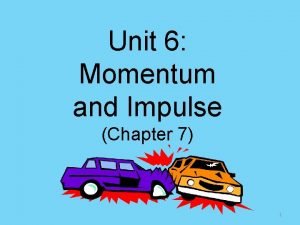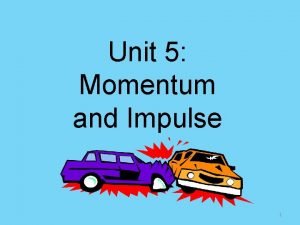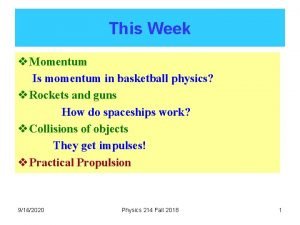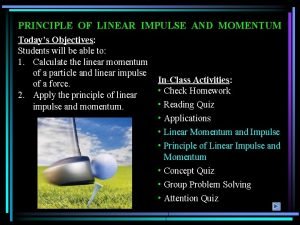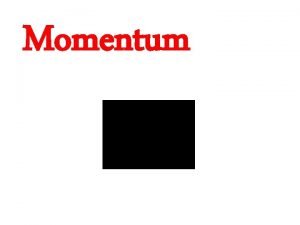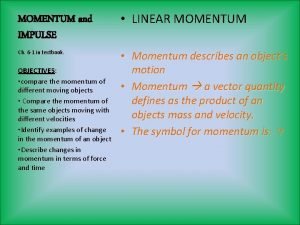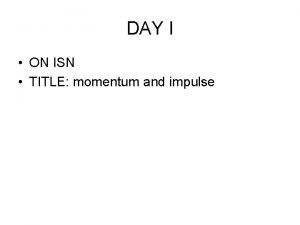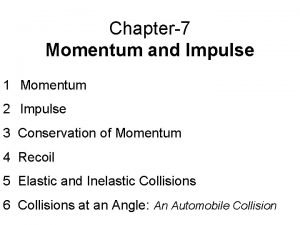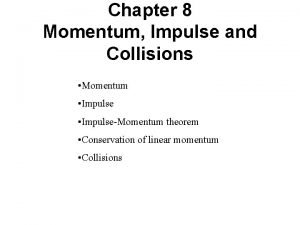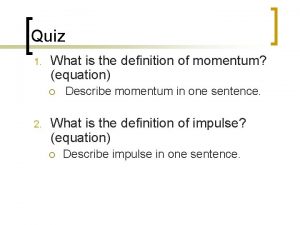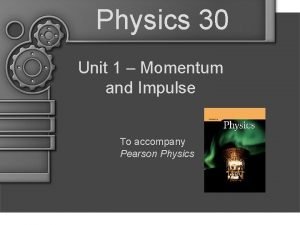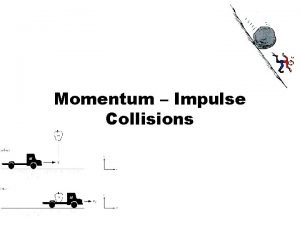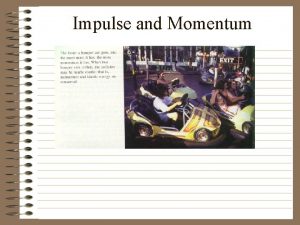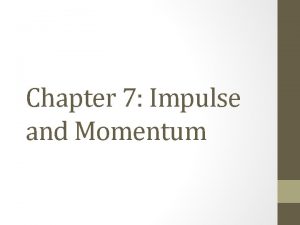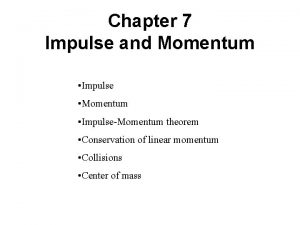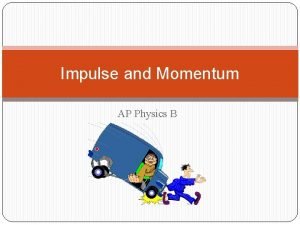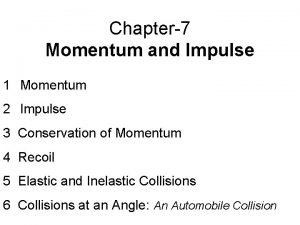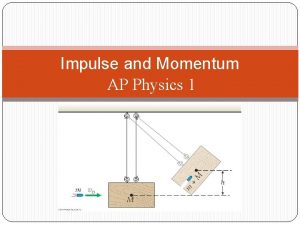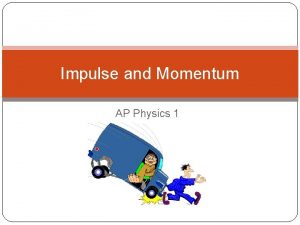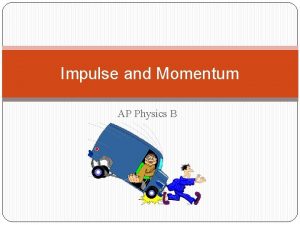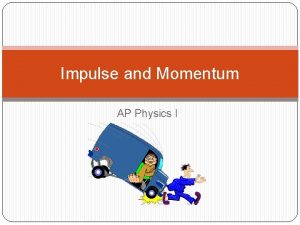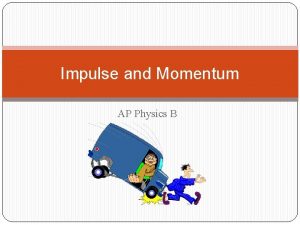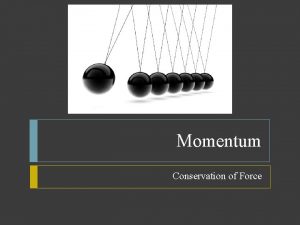Chapter 9 A Impulse and Momentum IMPULSE F

















- Slides: 17

Chapter 9 A - Impulse and Momentum

IMPULSE F Dt Impulse J is a force F acting for a small time interval Dt. Impulse: J = F Dt

Example 1: The face of a golf club exerts an average force of 4000 N for 0. 002 s. What is the impulse imparted to the ball? Impulse: J = F Dt F J = (4000 N)(0. 002 s) J = 8. 00 N s Dt The unit for impulse is the Newton-second (N s)

Impulse from a Varying Force Normally, a force acting for a short interval is not constant. It may be large initially and then play off to zero as shown in the graph. In the absence of calculus, we use the average force Favg. F time, t

Example 2: Two flexible balls collide. The ball B exerts an average force of 1200 N on ball A. How long were the balls in contact if the impulse is 5 N s? A B Dt = 0. 00420 s The impulse is negative; the force on ball A is to the left. Unless told otherwise, treat forces as average forces.

Impulse Changes Velocity Consider a mallet hitting a ball: F Impulse = Change in “mv”

Momentum Defined Momentum p is defined as the product of mass and velocity, mv. Units: kg m/s p = mv m = 1000 kg Momentum p = (1000 kg)(16 m/s) p = 16, 000 kg m/s v = 16 m/s

Impulse and Momentum Impulse = Change in momentum F Dt = mvf - mvo F Dt mv A force F acting on a ball for a time Dt increases its momentum mv.

Example 3: A 50 -g golf ball leaves the face of the club at 20 m/s. If the club is in contact for 0. 002 s, what average force acted on the ball? Given: m = 0. 05 kg; vo = 0; + F Dt mv Dt = 0. 002 s; vf = 20 m/s Choose right as positive. 0 F Dt = mvf - mvo F (0. 002 s) = (0. 05 kg)(20 m/s) Average Force: F = 500 N

Vector Nature of Momentum Consider the change in momentum of a ball that is dropped onto a rigid plate: + vf vo A 2 -kg ball strikes the plate with a speed of 20 m/s and rebounds with a speed of 15 m/s. What is the change in momentum? Dp = mvf - mvo = (2 kg)(15 m/s) - (2 kg)(-20 m/s) Dp = 30 kg m/s + 40 kg m/s Dp = 70 kg m/s

Directions Are Essential 1. Choose and label a positive direction. v 0 + vf vf = +10 m/s v 0= -30 m/s 2. A velocity is positive when with this direction and negative when against it. Assume v 0 is 30 m/s to the left and vf is 10 m/s to the right. What is the change in velocity Dv? vf – v 0 = (10 m/s) – (-30 m/s)

Example 4: A 500 -g baseball moves to the left at 20 m/s striking a bat. The bat is in contact with the ball for 0. 002 s, and it leaves in the opposite direction at 40 m/s. What was average force on ball? + m = 0. 5 kg - 20 m/s F Dt = mvf - mvo F + 40 m/s Dt vo = -20 m/s; vf = 40 m/s F(0. 002 s) = (0. 5 kg)(40 m/s) - (0. 5 kg)(-20 m/s) Continued. . .

Example Continued: + m = 0. 5 kg F - 20 m/s + 40 m/s Dt F Dt = mvf - mvo F(0. 002 s) = (0. 5 kg)(40 m/s) - (0. 5 kg)(-20 m/s) F(0. 002 s) = (20 kg m/s) + (10 kg m/s) F(0. 002 s) = 30 kg m/s F = 15, 000 N

Impulse in Two Dimensions + + vfy Fy vf F vfx vo Fx F = Fx i + Fy j A baseball with an initial velocity vo hits a bat and leaves with vf at an angle. Horizontal and vertical impulse are independent. vo = vox i + voy j Fx Dt = mvfx - mvox vf = vx i + vy j Fy Dt = mvfy - mvoy

Example 5: A 500 -g baseball travelling at 20 m/s leaves a bat with a velocity of 50 m/s at an angle of 300. If Dt = 0. 002 s, what was the average force F? + + 50 m/s vfy vf 300 Fy F Fx vox = -20 m/s; voy = 0 vfx = 50 Cos 300 = 43. 3 m/s vo vfy = 50 Sin 300 = 25 m/s -20 m/s First consider horizontal: Fx Dt = mvfx - mvox Fx(. 002 s) = (0. 5 kg)(43. 3 m/s) - (0. 5 kg)(-20 m/s)

Example Continued. . . Fx(. 002 s) = (0. 5 kg)(43. 3 m/s) - (0. 5 kg)(-20 m/s) Fx(. 002 s) = 21. 7 kg m/s + 10 kg m/s) + + 50 m/s vfy vf vfx Now apply to vertical: vo Fy Dt = mvfy - mvoy 0 20 m/s Fy(. 002 s) = (0. 5 kg)(25 m/s) 300 Fy F Fx Fx = 15. 8 k. N Fy = 6. 25 k. N and F = 17. 0 k. N, 21. 50

Summary of Formulas: Impulse J = Favg. Dt Momentum p = mv Impulse = Change in momentum F Dt = mvf - mvo
 Conceptual physics momentum
Conceptual physics momentum Work energy theorem
Work energy theorem Unit 6 momentum and impulse
Unit 6 momentum and impulse Unit of momentum and impulse
Unit of momentum and impulse How to find initial momentum
How to find initial momentum Linear impulse momentum equation
Linear impulse momentum equation Linear impulse and momentum
Linear impulse and momentum Importance of momentum and impulse
Importance of momentum and impulse Momentum and impulse poem
Momentum and impulse poem How does impulse relate to momentum
How does impulse relate to momentum Importance of momentum and impulse
Importance of momentum and impulse Impulse momentum
Impulse momentum Unit of momentum and impulse
Unit of momentum and impulse Unit for momentum
Unit for momentum Momentum and impulse quiz
Momentum and impulse quiz Physics 30 worksheet # 1 momentum
Physics 30 worksheet # 1 momentum The momentum of an object at rest
The momentum of an object at rest Mel physics
Mel physics


